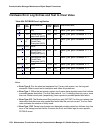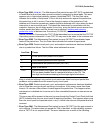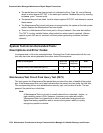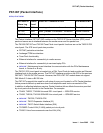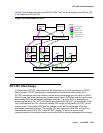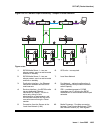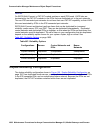
Communication Manager Maintenance-Object Repair Procedures
1800 Maintenance Procedures for Avaya Communication Manager 3.0, Media Gateways and Servers
S8700 | 8710
: If the active IPSI’s Packet Interface module causes a MAJOR alarm in a high- or
critical-reliability system (with duplicated IPSIs), an IPSI interchange occurs if the standby IPSI’s
state of health (SOH) is high enough to permit the interchange. A MAJOR alarm due to a failure
of the standby IPSI’s Packet Interface module lowers the standby’s state of health (SOH),
preventing a subsequent interchange.
The links that pass through the Packet Interface are identified as application links or system
links as follows:
● Application links are endpoints that require connectivity to the media server via the C-LAN
board’s Socket interface. These links pass over the packet bus, and through C-LAN ports.
The following system features use application links:
- Call Detail Recording (CDR)
- Dial-up administration
- Property Management System (PMS)
- Journal printer
- Wake-up log printer
- Announcement circuit pack upload/download of recorded messages
- IP phones
● System links
- Expansion Archangel links (signaling links for call setup of a PN’s endpoints)
- Center Stage Control Network (CSCN) links
- ISDN-PRI D-channel signaling links
- ISDN-BRI D-channel broadcast and point-to-point signaling links
- Adjunct Switch Application Interface (ASAI) links
- Remote Socket Control Link (RSCL) (C-LAN, VAL)
- BRI (TRK and STA)
Distributed PKT-INTs
In earlier G3r systems, every PKT-INT resided in the Processor Port Network (PPN) and
terminated all of the LAPD links. LAPD links are now terminated by the PKT-INT modules within
IPSIs that are distributed out to the PNs, or out to every PN for the S8700 IP Connect. The
DEFINITY Server R allowed up to three active and three standby PKT-INTs in the PPN.
S8700 MC: As shown in Figure 104: Distributed PKT-INTs on page 1801, PNs 1 and 2 have
IPSIs that terminate LAPD links. PNs 3 and 4 do not have local IPSIs, so their LAPD links are
terminated by IPSIs in PNs 1 and 2.



